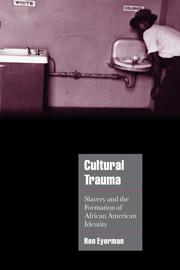Book contents
- Frontmatter
- Contents
- Acknowledgments
- 1 Cultural trauma and collective memory
- 2 Re-membering and forgetting
- 3 Out of Africa: the making of a collective identity
- 4 The Harlem Renaissance and the heritage of slavery
- 5 Memory and representation
- 6 Civil rights and black nationalism: the post-war generation
- Notes
- List of references
- Index
- Cambridge Cultural Social Studies
6 - Civil rights and black nationalism: the post-war generation
Published online by Cambridge University Press: 22 September 2009
- Frontmatter
- Contents
- Acknowledgments
- 1 Cultural trauma and collective memory
- 2 Re-membering and forgetting
- 3 Out of Africa: the making of a collective identity
- 4 The Harlem Renaissance and the heritage of slavery
- 5 Memory and representation
- 6 Civil rights and black nationalism: the post-war generation
- Notes
- List of references
- Index
- Cambridge Cultural Social Studies
Summary
Before I was an African American, I was a black kid living in Los Angeles who wanted to be a rock‘n'roll star. Then I discovered Harlem, and, ever since, I've wanted to be a Negro.
Shawn AmosThe two narrative frames developed through cultural trauma and transmitted across generations in a discursive process of symbolic representation were reformed in the 1960s through the cognitive praxis of the black nationalist and the civil rights movements. As part of the same process of remembering and forgetting, inherited models of emancipation were transformed and revitalized by a new generation of intellectuals. Through their form and content these interconnected, yet distinctive, social movements reflected the changes that American society and black Americans had undergone since the end of the Second World War. At the same time as these movements were structured by the inherited narrative frameworks, the frameworks were refigured as movement intellectuals articulated collective identity in an altered historical context. In one sense, these movements competed with each other in the struggle to determine how the collective would understand itself and the meaning of its collective past. In another sense, they complemented each other through the necessity of coming to terms with slavery as the primal scene upon which the collective was grounded.
Confrontation occurred at the level of action and cognition, effecting change in both.
- Type
- Chapter
- Information
- Cultural TraumaSlavery and the Formation of African American Identity, pp. 174 - 222Publisher: Cambridge University PressPrint publication year: 2001

